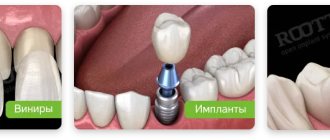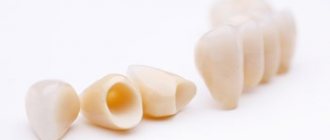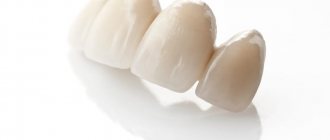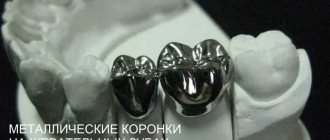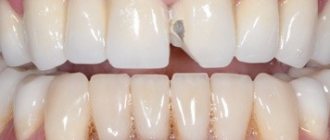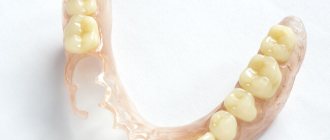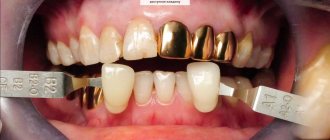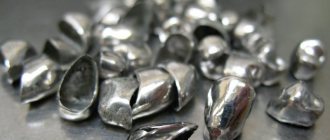From this article you will learn:
- types of dental crowns,
- crowns on teeth – which ones are better, reviews,
- how much does it cost to put a crown on a tooth - for 2022.
An artificial crown (Fig. 1) is a tooth prosthesis that restores its anatomical shape, aesthetics and chewing function. Single artificial crowns are used in dentistry to strengthen severely damaged teeth. For example, according to the rules, if the crown part of a tooth is destroyed by 1/2 or more, its restoration should no longer be done with a filling, but with a crown. The second purpose of dental crowns is to restore missing teeth.
In this case, dental crowns are made in the form of a bridge-like prosthesis, in which the intermediate part restores the missing tooth, and the side crowns are fixed on the ground abutment teeth (located at the edges of the dentition defect). However, for this option of bridge prosthetics there is a limitation - the patient should be missing no more than 2 teeth in a row. But crowns and bridges can be fixed not only on ground teeth, but also on dental implants, which will allow you to keep neighboring teeth alive and healthy.
Crown on a tooth: before and after photos
Before dental prosthetics with crowns, teeth require special preparation. For example, the crown part of a tooth destroyed by caries must first be restored with filling material. Root canal filling may also be necessary. After all this, the teeth are ground down for crowns and impressions are taken, based on which the crowns for the teeth will be made.
Indications for prosthetic crowns –
- if the crown of the tooth is destroyed by 1/2 or more,
- prosthetics for missing teeth,
- severe tooth wear,
- the need to change the color and shape of the tooth,
- the need to change the position of one or more teeth - as an alternative to correcting the bite with braces.
Important: in dentistry there is a rule (which does not prevent many dentists from violating it) - that a tooth should be taken under an artificial crown if its destruction reaches 1/2 or more of the volume of the coronal part of the tooth. However, very often dental therapists do not want to give their earnings to their colleagues - orthopedic dentists (prosthetists), trying to restore such teeth themselves using pins and filling material.
In such cases, the remaining walls of the tooth very often cannot withstand the chewing load, which leads to breakage of the walls (and if the lower part of the moving fragment goes under the gum, then to tooth extraction). Such problems arise especially often in pulpless teeth, i.e. from which the nerve was removed and root canals were filled. This is also due to the fact that after removing the neurovascular bundle from the tooth, hard tissues become much more fragile.
Contraindications for crowns –
- tooth mobility,
- when the clinical height of the tooth crown is low (in this case, the artificial crown made for the tooth will constantly fall off),
- poorly filled root canals,
- periodontitis (focus of inflammation at the apex of the root),
- for bridges supported by teeth ground for crowns, the contraindication is the patient’s absence of more than 2 teeth in a row (for bridges supported by implants, there is no such contraindication).
Dental crowns in our clinic
At OWN PEOPLE dentistry, crowns are selected individually for each patient. Our doctors will take into account all the client’s wishes, including the appearance of the prosthesis. One of the main principles of the clinic is the availability of care. Therefore, when selecting a crown, dentists also focus on the patient’s budget and the cost acceptable to him.
All stages of manufacturing and installation of crowns are controlled by the attending physician. This ensures high quality and long-lasting wear of the prostheses. And after installation, the dentist conducts a detailed consultation on wearing and caring for the crown.
Free consultation!
Our clinic provides free consultations, during which the dentist will determine whether the patient needs a crown and outline a rough treatment plan. You can discuss with him the materials and methods of making prostheses in order to choose the most convenient one. The doctor will also tell you what procedures will have to be completed before installing a crown and what costs the patient should expect.
Indications for installation
Artificial crowns are installed in place of the destroyed part of the tooth. The procedure is carried out according to indications:
- more than 70% of the natural tooth crown is destroyed;
- inability to use other correction methods;
- there are large cracks and chips on the enamel;
- a fracture of the natural crown was established;
- high abrasion of enamel in the patient.
Temporary crowns are installed while the tooth is being treated. They allow you to maintain an aesthetic appearance and a beautiful smile.
Contraindications
Not all patients can have crowns. Contraindications to the procedure:
- the last stage of periodontitis - the prosthesis may fall out due to weakened jaw tissue;
- enamel fragility - due to the risk of tooth decay;
- Bruxism - increased tone of the jaw muscles during stress or sleep;
- small height of the teeth and their incorrect position - the crown will not hold;
- pathological bite with incisal overlap - artificial crowns will wear out and destroy healthy teeth.
For some crown materials there are age restrictions for use. Therefore, only a doctor can choose the right prosthesis during a personal consultation.
Our advantages
At the OUR PEOPLE clinic, they value the health of their patients, so doctors install crowns only when indicated. If this method of prosthetics is not suitable, the dentist will select another correction method. An individual approach and attention to each patient is the key to high quality medical care at the SVOI PEOPLE clinic. Thanks to this, our clients wear dental crowns for many years.
Indications for dental prosthetics with veneers
Veneers are thin plates that cover the front surface of the tooth and change its aesthetic characteristics. The fundamental difference is the minimal preparation of hard tissues. After installation, they are not noticeable in the mouth when talking and smiling and are the most aesthetic option for an orthopedic design.
Dental prosthetics with veneers
Veneers may be an option for:
- Change in color of pulpless teeth;
- Injuries (chips and cracks);
- Cosmetic defects of the vestibular surfaces of the anterior teeth;
- Fillings that do not satisfy aesthetic requirements and have pronounced discolorations;
- Large enamel defects, diastema and trema;
- Correction of teeth position.
What are they: materials
Crowns can be made from a wide range of materials. Some of them contain a metal base, others are completely synthetic. The choice of material depends on the purpose of the crown, wearing time, wishes for appearance and financial capabilities of the patient.
Metal ceramics
Crown with a metal frame and ceramic coating. The material is reliable and aesthetically pleasing. But there are several contraindications to metal-ceramic dental crowns:
- gum recession - the denture becomes visible;
- age under 18 years - thin enamel in children, which is why there is a risk of injury to the pulp when grinding the tooth.
For the adult population, metal-ceramic crowns are considered an excellent option for correcting dentition.
Metal composite
The product has a frame made of an alloy of cobalt and chromium, and a photopolymer composite is used for cladding. The crown is formed in a soft state and then hardens under the light of an ultraviolet lamp.
The result is a thin and durable coating. But the photopolymer composite is colored by bright pigments in food and drinks, so the patient will have to limit himself in consuming such products.
Golden
The material, tested by time and many patients, is gold. It is a precious metal, so it is hypoallergenic. Such products are perfect for people with high sensitivity to foreign materials.
Gold is a soft metal, which is why crowns quickly wear out under the pressure of antagonists. But they do not spoil the enamel of healthy teeth.
Zirconium dioxide
The most modern material for making crowns is zirconium dioxide.
| pros | Minuses |
| High strength; | High price. |
| Aesthetics; | |
| Hypoallergenic; | |
| Long service life. |
In terms of the ratio of advantages and disadvantages, this material is the most optimal of all possible. But the high price is not for everyone.
Metal-free
Modern techniques for making crowns make it possible to avoid metals in the composition of the product. This is especially important for those who are allergic to them, and you don’t want to lose aesthetics by installing a gold model.
Ceramic
Ceramic crowns are the most similar to natural teeth. They have a sufficient degree of transparency, and can also be matched in color to match natural enamel.
But such crowns are fragile and fragile. Therefore, they are used for the front teeth, and for the back teeth you will have to choose a different material.
Porcelain
Porcelain crowns are not as popular, but they have many advantages.
| pros | Minuses |
| Anatomical shape; | Fragility; |
| High accuracy; | High price; |
| Comfortable wear; | Loose fit; |
| Strong fixation; | High risk of destruction of adjacent teeth. |
| Minimal risk of loosening; | |
| High aesthetics; | |
| Durability; | |
| No staining; | |
| Resistance to temperature changes; | |
| Hypoallergenic. |
In terms of the ratio of pros and cons, porcelain products win in many respects. But people with thin enamel are not recommended to have them installed due to the risk of damaging healthy teeth.
Combined
Models made from combined materials are suitable for long-term wear. They can be used for teeth with any location: they are aesthetically pleasing for the front ones and can withstand the load of the back ones.
Such products are not without drawbacks. They quickly wear out and wear out, and can become deformed. But this is a fairly budget option for prosthetics.
Plastic
The products are only suitable as a temporary tooth replacement. They are light and comfortable, their production takes little time and does not require a large budget. While the permanent structure is being prepared, you can use plastic crowns, but you won’t be able to wear them for a long time - they simply won’t withstand the load.
Metal-ceramic crowns –
Such crowns have a metal frame 0.3-0.5 mm thick inside, which is lined with layers of ceramic mass (porcelain) on the outside. In the budget version, the metal frame is made by casting from CHS (cobalt-chromium alloy), but it is also possible to manufacture the frame from alloys of precious metals - such as gold and platinum. Although in this option the cost of 1 Unit of metal ceramics will already be equal to the cost of metal-free ceramics, and at the same time it will still be inferior to it in aesthetics.
The advantages of metal-ceramic prosthetics include high strength, fairly good aesthetics, and, in a budget version, also an acceptable cost. The disadvantages are: 1) the need to grind off a large amount of tooth tissue, 2) the need to depulp teeth, 3) the appearance of cyanosis of the gums around the crown, 4) over time, gum recession may occur, and as a result, the edge of the metal frame may begin to peek out from under the gums. The last two points are especially critical when it comes to crowns on the front teeth - especially in patients with a “gummy type of smile.”
Metal-ceramic crowns: photo
A sharp blueness of the gums and the edge of the metal frame peeking out from under the gums can make the aesthetics unsatisfactory, although this may not be important when it comes to prosthetics of the chewing group of teeth. These problems arise due to the fact that the metal frame of metal ceramics in the standard version is lined with porcelain on all sides (but with the exception of the lower edge, which will be in contact with the gum). And therefore, the thinner the patient’s gum thickness, the more the metal will shine through it, giving it a bluish color.
This can be avoided by using “metal-ceramics with shoulder mass”. For such crowns, the lower edge of the metal frame will also be lined with porcelain, but due to the complexity of manufacturing, this option will cost + 5,000 rubles to the price of 1 Unit in the standard version. But if you decide to opt for metal-ceramics, then you need to pay great attention to what ceramic mass will be used to make your crowns.
The cost of a metal-ceramic crown is
One crown, made from good budget ceramics “Duceram” (Germany) and high-quality cobalt-chromium alloy, will cost an average of 12,000 rubles per 1 Unit. At the same time, if ceramic masses of a higher level are used (allowing one to achieve really good aesthetics), the price in clinics of the middle price category will already be from 15,000 to 18,000 rubles. Examples of manufacturers of high-quality ceramic masses are (Liechtenstein), Vita (Germany), Noritake (Japan).
And usually this is always indicated in clinic price lists (for example, “Ivoclar metal-ceramic crown”). Because each of these manufacturers produces ceramic masses of different levels, we will indicate their more detailed names, and the best ones are “Ivoclar - IPS InLine”, “Noritake EX-3”, “Vita VMK Master”, as well as “Creation” and "Initial". But remember that a good ceramic mass is only half the success (the ability to achieve good aesthetics). The second half is a good, talented dental technician, of whom not everyone is capable of making metal-ceramics similar in color and transparency to the adjacent real teeth.
What other extra charges might there be? –
If you want metal ceramics with shoulder mass, then you will have to pay about 5,000 rubles in addition to the cost of 1 Unit. Metal ceramics based on gold-palladium or gold-platinum alloy will cost approximately 25,000 rubles + the cost of gold (+ 5,000 rubles per gram). Together with the cost of gold, 1 crown will cost approximately 32,000 rubles. Remember that all prices above do not include preparation of teeth for prosthetics, production of temporary crowns made of plastic.
Another option is that the metal frame can be made from CHS, but not by solid casting, but by milling on a computer-controlled machine (CAD/CAM technology). This is a much more precise option for making frameworks, but it is only really important when it comes to metal-ceramic bridges over long distances. Because Since this article is only a review, we have briefly outlined the most important criteria when choosing metal-ceramics, and you can read more about this type of crown at the link above.
Types and methods of making a crown
Products differ not only in service life and materials of manufacture, but also in appearance. The doctor selects the appropriate option during a personal consultation, since an in-person examination of the patient is required.
Bridges
The design is relevant for patients who are missing more than one tooth. In this case, a complex prosthesis is made, the parts of which are connected by a bridge. It is attached to healthy teeth, thus holding crowns. This method is not used for single prosthetics.
Implant supported crowns
If the patient has already installed implants, they can be used as a support for the crown. This will avoid unnecessary stress on healthy teeth and prevent their wear. But if the patient does not have implants, this technique cannot be used.
Crown for one tooth
Most often, patients come with a request to install a crown on one tooth. This is relevant for single destruction from caries or injury. The method of installing a crown is selected based on the condition of the gums, periodontium and bone plates. In some cases, additional operations are required before installing the structure.
Fixation with a pin
A method that is used less frequently than others is placing the crown on a pin. This is a traumatic operation that can cause serious complications. Therefore, they try to abandon this method if alternative methods are available to the patient. If not, the operation is carried out in several stages with constant medical supervision at each of them.
Cast crowns
The most reliable and durable designs are cast crowns. They are made from a single piece of material. The product is highly durable and lasts longer. But this manufacturing technique is not suitable for all materials.
Stamped
To stamp crowns, a dental anvil is used, the processes of which follow the shape of the teeth. To get a stamp, use rubber rings. To make metal crowns, hammers of various sizes and shapes are used. The final form of the prosthesis takes place after processing with special forceps.
Such dentures are cheaper to produce than cast ones. But they are easier to deform and wear out faster. The service life of such prostheses is much shorter.
Care
- Brush your teeth twice daily, as directed by your dentist.
- Use dental floss, a brush or a irrigator to care for the interdental spaces and pontics.
- Even the strongest crowns can be damaged by excessively hard food, so you should not bite nuts, candies, etc. with your teeth.
- Do not eat food at sharply contrasting temperatures, as this can cause microcracks in the ceramics and enamel of the teeth.
- When brushing your teeth, do not forget to pay attention to your gums and make light massage movements.
- Visit your dentist every 6 months and have professional oral hygiene done. In this case, crowns and teeth will serve you for a very long time.
Article material approved by doctor: Evgeniy Aleksandrovich Nikitin Dentist-therapist, orthopedist, pediatric dentist
10 years
How a tooth crown is made
Before you start making a crown, you need to decide on its shape and size. To do this, do:
- visual inspection;
- overview and targeted x-ray;
- 3D – computer visualization of a model of the jaw and tooth.
Making a crown for a tooth depends on its type, the material used and the production method. An impression of the patient's jaw is taken as a sample. They are sent to the laboratory to create a plaster model. After drying, the master cuts out the desired element and makes a prototype of it from wax.
Then the resulting model is fixed on the base and filled with a specialized mixture. In this state it remains in the oven for 4-5 hours. Then the mold is taken out and, while it is still hot, filled with alloy. Until the moment of hardening, the future artificial tooth remains in such a position so that its deformation does not occur.
Installation process
The procedure for installing a crown is multi-stage. Often the patient has to visit the doctor more than two or three times. It all depends on the initial condition of the teeth and their sensitivity to the therapy, if necessary.
At the initial stage, the doctor conducts a diagnosis, determines the plan and scope of work, and calculates the approximate cost. Often at this time it is still unclear how long the treatment will take, because each body reacts to therapy in its own way.
Laboratory stage
Most of the steps involved in installing a crown take place in the laboratory. At this stage:
- obtain dismountable models of jaws from plaster;
- make a stamped crown;
- grind and polish the product to an ideal shape.
The laboratory accompanies the patient at all stages of installation. The crown can be returned for revision even at the very last moment, since it is important that the patient feels comfortable wearing it.
Grinding the tooth before installation
The most difficult stage, which most patients fear, is teeth grinding. It is necessary to ensure that the crown fits perfectly to the gums. If this is not observed, a pathological pocket will form. Food will get stuck in it, which will cause inflammation and can lead to tooth extraction.
Grinding is carried out under anesthesia, so the patient will not feel anything. Only the top layer of enamel is ground. The tooth itself is not damaged; only 1-2 mm are removed. The depth of work depends on the selected crown material: a smaller volume is sufficient for ceramics, while metal-ceramics require more space.
The purpose of grinding is to equalize the width of the tooth at the neck and at the equator. This is necessary for strong fixation of the crown. It is covered by the gums, which prevents loosening. After processing, there should be no convex parts left - they are sanded off with a special apparatus. At the same time, the chewing teeth must maintain their relief in order to fully perform their functions.
In some cases, during turning, depulpation is additionally performed. This is done according to strict indications, about which the patient is warned in advance.
In case of extensive tooth decay, a stump inlay can be installed. It protects healthy soft tissues from the pressure of the crown on them. Previously, in this case, installation was carried out using pins. Now this technique is not so relevant, since the operation is associated with certain risks. And if it is possible to avoid them using a stump tab, it is better to do so.
Installing a crown on a tooth
A permanent crown is not installed immediately. First, a fitting is carried out, during which the patient evaluates several parameters:
- shape;
- wearing comfort;
- color.
If one of the parameters does not fit, it is better to redo the crown. After all, you need to remember that it will take a long time to wear it, and the cost of manufacturing and installation is usually expensive.
And the appropriate crown is securely fixed with cement. The strength of the installation is checked by a doctor to ensure that the prosthesis does not accidentally fall out.
Monitoring the situation after installation
Once the crown is in place, you need to check whether the installation was completed correctly. To do this, a panoramic or targeted photograph of the oral cavity is performed, depending on the number of installed dentures. Only after this the doctor allows the patient to go home.
If a patient has questions about discomfort or inconvenience when wearing a crown, he can call the doctor at the OWN PEOPLE clinic and ask all his questions. Our dentists care about their clients and are always responsible for the results of the procedure.
Preparation for prosthetics
Preparing to install a dental crown is a long process, but necessary if you want the denture to last for many years and not cause any discomfort. Classical training takes place in 7 stages.
- Examination by an orthopedist
The doctor can give an opinion on the advisability of prosthetics using a dental crown at the initial appointment after a thorough examination of the oral cavity. He will assess the condition of your teeth and gums. Offer an individual treatment plan. Will inform you about which crown material is preferable in your particular case. He will select the optimal color for the future crown so that it cannot be distinguished from natural teeth. Finally, he will calculate the final cost of the service and the deadline for its completion. - X-ray
Having a targeted X-ray image of the problem tooth is the main condition when preparing for prosthetics. Based on the data obtained from it, the dentist will be able to decide whether it is in principle possible to restore the tooth with a crown or whether it is worth looking for alternative solutions to the problem. - Therapy
The third fundamentally important stage is the treatment of all foci of infection in the oral cavity. Before installing a crown, it is necessary to remove accumulated tartar and treat caries. - Pulp removal
In most cases, crown replacement is preceded by the process of tooth depulpation (or, as patients often say, “nerve removal”). Exceptions are possible if we are talking about prosthetics of lateral chewing teeth. - Preparation
In other words, the grinding of a tooth, when a layer of dentin equal to the thickness of the future crown is removed. It is performed using local anesthesia and takes 1 hour. - Taking impressions
In order for the crown to fit on the tooth as accurately as possible, impressions are taken from the teeth. If the clinic has its own dental laboratory, then making a prosthesis will not take much time. - Installation of an intermediate structure
A temporary prosthesis is necessary when it comes to teeth in the frontal zone. It will prevent you from walking around with an unaesthetic ground tooth in the period between fitting and fixing the permanent crown.
Pros and cons of crowns
It is impossible to call the installation of crowns a uniquely positive procedure. It has a number of contraindications and disadvantages. But there are much more advantages from it, so it has not lost its relevance for decades.
Advantages
There are significantly more positive aspects of crown prosthetics than negative ones. The advantages of the procedure include:
- maintaining the health of the tooth when it is partially destroyed;
- restoration of chewing function of the jaws;
- protection against tooth decay with removed pulp;
- restoration of intelligible and clear speech;
- possibility of crown replacement;
- restoration of the aesthetic appearance of the smile.
A large number of advantages outweigh some of the disadvantages of the procedure. But they are still worth considering before deciding to install.
Flaws
Like any medical procedure, crown placement is not without its drawbacks. Its disadvantages:
- significant grinding of healthy tooth tissue;
- the procedure is not performed if the root is damaged;
- limited crown service life;
- the need for regular monitoring by a doctor.
Despite the number of shortcomings, dental crowns remain popular and in demand. This is an effective way to restore the integrity of your smile and jaw function without significant financial investment.
Indications for dental prosthetics with bridge structures
Bridges are a non-removable orthopedic structure that is fixed to supports that limit the defect on both sides.
Bridges may be indicated if:
- Included dental defect, no more than 3 units in length;
- Lack of other options for restoring the integrity of the bite using another design or implantation;
- Replacement of a previously installed bridge.
If it hurts under the dental crown
Installing a dental crown is a complex operation. Therefore, after it, pain may be observed for 2-3 days. This is a normal reaction of the body to intervention. Therefore, doctors recommend taking painkillers during this period.
If your tooth hurts for a week or more, you should consult a doctor for a second examination. It is possible that a pocket has formed between the gum and the crown where food has entered. This can cause inflammation. In this case, you need to start treatment as early as possible so as not to lose the tooth.

